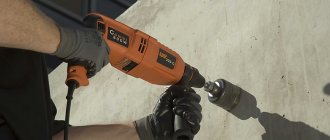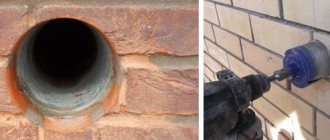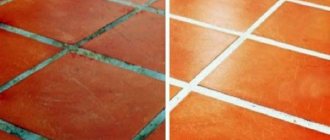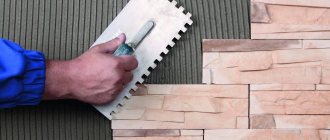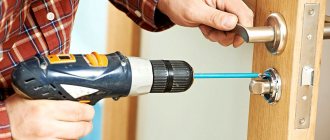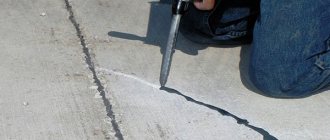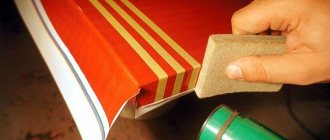March 13, 2019
There comes a time in every person’s life when it is necessary to make repairs to a house or apartment. And then the question arises about remodeling the space: moving sockets, updating wiring and drilling other holes to bring the design project of the room to life.
In the process of performing work, a variety of tools and drills are used. Of course, customers always prefer more powerful models. There is a large selection of tools on the market that can be used to organize work.
Selection principles
Most cases involve the use of hammer drills. This tool always has more power in reserve; it allows you to pierce even very thick walls. With this tool you can always drill into large areas. It is advisable to use it in the following situations:
- when you need to make a hole measuring up to 10 - 12 mm;
- when many holes need to be drilled. Moreover, the size of each of them is supposed to be quite large;
- when working on coatings containing foam.
All craftsmen should know that drills can be classified according to their impact power. Some models can be used for drilling concrete, while others are designed for use with specific attachments. It is important that the alloy from which the nozzles are made is of high quality. High-quality alloys are the guarantee that the drill will not fail for a long time.
Selection of nozzles
The correct choice of nozzles is extremely important. For work, special nozzles of increased strength are required.
The following types are used:
- Toothed bits for impact drilling.
- Diamond bits. Their edges have special cutouts and are coated with diamond chips or corundum. They are distinguished by increased strength (they even cut reinforcement) and accuracy: the surface of the hole is perfectly smooth. They work without shock.
Diamond-coated crown Source yunimag.ru
- KS-crowns. Their edges are coated with larger diamond particles.
When working with a drill, a punch may be required. This is a special durable pin that is used for crumbling concrete. Instead, you can use a pin, core, or even an old drill.
See also: Catalog of companies that specialize in the design and reconstruction of houses of any complexity
It all depends on the nozzle
Before starting repairs, it is necessary to draw up a small estimate for installation work in order to understand exactly what equipment will be needed in the process.
All drill attachments can be divided by type of work:
- for making holes;
- for corner drilling;
- drill stops;
- for grinding;
- for cutting;
- for polishing;
- mixer attachments.
And also by the type of material on which the work takes place:
- concrete;
- tile;
- tree;
- metal.
Important factors are also the length of the equipment and the alloy from which the nozzle is made.
What kind of work may require drilling:
- laying plumbing lines;
- gating walls for laying electrical cables;
- drilling socket boxes;
- small holes for wall cabinets and shelves.
Concrete drilling – simple and professional
Professional machine for drilling large holes in thick walls
So, we may need holes in the walls for different purposes; accordingly, its diameter and depth will depend on this. The photo above shows how a special water-cooled installation bites into the thickness of concrete with a powerful crown - such large holes are needed for the installation of communication lines, ventilation, sewerage and other things. The need for tools that can cope with such a task has recently increased many times over, since almost everything is now built using monolithic technology. For brick walls, this is also sometimes required, for example, the builders did not provide an exhaust hood, or a neat outlet from the boiler needs to be made.
Through drilling of a brick wall
This approach allows you to cope with the task in the shortest possible time, plus the strength of the wall is not compromised. Only a few can afford such equipment, and there is no point in buying it. Only specialized organizations are engaged in professional drilling. We will not describe the process of diamond drilling in detail, but we will go through the main points to broaden our general horizons.
Table 1. Instructions for drilling concrete.
| Steps, images: | Description |
| Step 1. Drilling a hole for the frame.
| Good equipment has a frame along which the cutting bit moves in the desired direction. In order to properly secure the frame to the wall, you will need to make a hole in it strictly perpendicular to it. |
| Step 2. Fixing the bed.
| We fix the frame using a powerful metal anchor. The tool is now ready for use. |
| Step 3. Setting up the machine.
| Then the operator sets the value of rotation speed and axial load. It is very important to choose the correct settings for a specific material, otherwise the drilling process may take several hours, and the hole will not be smooth. |
| Step 4. Drilling.
| We start drilling and do this until the crown goes through the entire wall. As a result, we get a perfectly smooth hole, a minimum of dirt and dust. |
Interesting to know! The cutting tool must be constantly cooled. If the hole is large and the wall is thick, organize the water supply through special hoses. This measure allows for less dust.
Now, from professional tools, let's move on to more mundane ones, to those that we constantly encounter in practice. Concrete is a very hard material . In addition, reinforcing rods made of steel or fiberglass can pass inside it. A tool with a shock function can cope with its drilling - the impulse from the drill will destroy the material more effectively. You should not use a simple electric drill. No, you will make a hole, but you will spend about 10 minutes on it, not 10 seconds. Agree, the difference is colossal.
Interesting to know! If the hole diameter is less than or equal to 13 mm, then an impact drill will be enough for the job. Large ones can only be made with a hammer drill.
A screwdriver can only handle lightweight concrete, and even then not everyone
Prices for popular models of screwdrivers
Screwdrivers
Concrete walls also include lightweight concrete - foam blocks, gas blocks. These materials are not very dense, so even a screwdriver may be enough for the job if it has a fast and powerful electric motor.
Video – Diamond drilling of holes in concrete and reinforced concrete walls HD 1080
The next important point is the selection of a drill. Concrete and other hard materials, such as brick, can only be drilled with carbide tools - Pobedit drills. A very durable one will win; a drill tip is made from it, after grinding it down, the device becomes unusable.
Pobedite drill tip
Advice! If you try to use these drill bits on wood, you will end up with unsightly jagged holes. Wood is too soft for him.
Prices for diamond drilling rig
Diamond Drilling Rig
Having prepared everything you need, you can start working:
Step 1: First we need to do some preparation. The main problem may be the presence of electrical wiring or water supply and heating pipes . To avoid an accident, you need to make sure you don't get caught in them. A metal detector or a special device that responds only to wiring can help in this matter. Pipes inside walls, if they are made of polypropylene and other polymers, will be found by a metal detector only if they have metal reinforcement. Otherwise, you need to look at drawings or photographs of communication lines.
Metal detector for walls
Step 2. Before drilling, you need to mark the entry point of the drill; for this you can use a pencil, marker or punch, if you need not only marking, but also a hole so that the drill does not slip. Usually, when you start drilling concrete or brick, the drill doesn’t go too far to the side, but it can still lead and the hole moves a little. In some situations this is uncritical, but in others, on the contrary, it is unacceptable, for example, you need to screw a bracket that has a strict arrangement of holes for anchors.
Center punches of different sizes
If the wall surface is decorated with ceramic tiles, then it is even more difficult to start drilling without a center punch, especially if the tile is glossy - the drill will slip over it even more, leaving scratches. If you don’t have such a device at hand, then you can replace it with a classic dowel , which will not bend from hammer blows, or start drilling at the lowest speed, and only after making sure that the drill goes as it should, accelerate the tool.
Step 3. Small holes are used mainly for plastic dowels and metal anchors - in the first case, it is recommended to make the hole a little deeper than the length of the element, literally 3-5 mm. If this is not provided for, it may not go all the way, will remain protruding above the plane of the wall, or will break completely. This feature is typical of dowels due to their shape.
This is what the depth limiter looks like
Step 4. There are very thick walls, and the depth of the hole will not play a special role for them, especially if the dowel has a stopper cap that will prevent it from slipping inside. And there are thin partitions, where overdoing can lead to damage to the finish on the other side, plaster falling off, and so on. In this case, it is necessary to accurately determine the depth of the drill . For this purpose, limiters are used in the form of rods, fixed in a special device on the additional handle of the hammer drill. Reliable and accurate, but not always.
There are some instrument models in which the fixation of the limiting rod is poorly thought out. It can slip through the hole, making its use risky and inconvenient. In this case, you can use the traditional method of indicating the drilling depth.
Homemade limiter made from electrical tape
Take a piece of electrical tape and wrap it at the desired level directly onto the drill. If you need to make many identical holes, then make sure that the edges of such a mark are not pressed down, since after several entries of the drill into the concrete, it can give an error. You can also make a mark on the drill with a marker, but it won’t last very long, as it will quickly be erased and become unnoticeable, especially in the debris that comes out of the hole.
Step 5. When drilling concrete, a lot of drilling waste, or simply dust, is released. When you work in a house that is just under construction, this does not create any interference, but if the premises are already residential, everything is equipped with furniture, and you don’t want to dirty anything, it becomes more difficult to drill a hole in the wall accurately. But we wouldn’t be us if we hadn’t come up with ways to deal with such a trivial problem:
- The photo below shows a hammer drill equipped with a vacuum cleaner and a dust bag. Working with such a tool is a pleasure - with good suction power, virtually no debris will enter the room. It is especially convenient to use it at heights.
Rotary hammer with vacuum cleaner
- Such equipment costs a lot of money, so less radical measures can be used. For example, use a home vacuum cleaner. You don't need to tape it to the hammer drill - just have someone hold the tube under the hole while you drill it. The effect will be no worse.
- In some situations, dust collectors, which come in the form of plastic or rubber bowls, help. It is convenient to work with these devices when drilling the ceiling, but they are not so well suited for walls, since when removing the drill, debris can spill out.
Tool with dust collector
- The simplest method is to use a damp cloth. While you drill, an assistant holds it from below and then carefully removes it. The remaining particles of debris on the wall are wiped off with a clean rag.
- If there is absolutely no one to help you, then you can make such a garbage container envelope, as shown in the photo below. To do this, you will need an old newspaper and masking tape, which, when peeled off, will not leave marks on the wall. It is glued just below the drilling point, and all waste will fall inside.
Garbage bin made from old newspaper
If all the dusty work has been completed and you need to prepare the wall for painting, then an article about wall putty will be very useful for the reader. In this material we will consider in detail the main types of putties and the tools that will be needed during the work process. As well as step-by-step instructions for applying putty to the wall.
How to drill concrete evenly with a drill
First you need to know for sure that the right nozzle has been selected. Drilling must always be done at low speeds. Typically, the tool is in use for 10 or 12 minutes. During this time, it is guaranteed that it will not overheat and accidentally break. If the tool drill accidentally remains in the thickness of the wall, you must carefully remove it. You cannot use force. Perhaps the drill will break and its fragments will remain in the thickness of the wall. If necessary, the drill can be easily detached from the attachment.
The drill must be held strictly perpendicular to the surface. If this is not observed, there is a risk of damaging the drill and sometimes leaving a dent. It is also important to ensure that drilling dust does not get into your eyes. To do this, purchase safety glasses. You can also use gloves to prevent your hands from slipping during the process. Only a person with sufficiently strong hands can drill a surface efficiently. Because the process requires significant effort.
A device for recessing into a wall surface - which one is better?
How to drill a hole in a wall – this question often arises for a beginner. Today it is not difficult to cope with such a task. If a person has at least minimal experience and uses modern electric tools in his work, he will definitely cope.
How to drill a hole in a wall correctly? It all depends on the surface material
To ensure that the room remains clean after all work, it is worth using a jig - thanks to it you can drill with a minimum amount of dust and dirt.
A hammer drill is perfect for creating holes in the wall if, for example, the wall needs to be insulated (or for other purposes) - professionals recommend using it. This technique easily copes even with high-strength materials; nothing better than a hammer drill for holes in the wall has yet been invented. But a high-quality tool is expensive, and almost no one buys it for home use. Another option for making holes in the wall is an electric drill, which has an impact effect.
Features of working with concrete pavement
First we select a drill. If the wall is made of concrete or brickwork, it is better to give preference to pobedit bits, since this tool turns the material into crumbs at the drilling site. But it is not suitable for other surfaces, for example, if you drill wooden boards with it, the fibers will tear and the hole will turn out sloppy.
When drilling a concrete surface, you need to take into account that there will be a lot of dust, so you need to prepare a vacuum cleaner to collect debris from the hole. This, of course, does not guarantee absolute cleanliness when performing work, but it allows you to reduce the amount of dirt.
Before you start drilling, you need to check whether there are any communications in that place. Damage to electrical wiring will entail the injection of additional funds into its restoration. The wall must first be ringed; for this you can use an alarm or a metal detector.
Now you can proceed directly to drilling holes in the concrete wall. First, we outline the place where the future hole will be with a construction pencil. We start drilling at low speed, this will improve the accuracy of the work. After this we increase the speed. The drill must enter the surface at one angle so that the drilling direction does not go astray and the hole is of the desired size.
If a hole is made for a dowel, it should be longer than the dowel itself so that it can be installed flush with the wall and not stick out.
Preparation and process
Before drilling into a concrete wall with a conventional drill, you need to inspect the tool, check its serviceability and insert the nozzle completely until it stops.
Then you will need to inspect the wall and check if wires and cables will be touched. If possible, you should also make sure that there is no reinforcement if you are using a non-diamond drill. If there may be reinforcement along the drilling path, it is necessary to prepare a metal drill.
Before you start drilling, you need to protect yourself: wear thick gloves, safety glasses, and insert earplugs or headphones.
Drilling a hole
First you need to mark the location and select the depth. Modern models usually have special limiters. If they are missing, you can put a mark on the nozzle.
A few examples will help you better understand how deep you need to drill: for a picture or a light shelf, 2.5 cm deep is enough.
Drilling with special attachments Source minemegashop.ru
When installing the dowel, the hole should be several millimeters longer. When the dowel is inserted, dust will form, which will take up extra space.
A hole is drilled in a brick or concrete wall in several steps:
- Having chosen a place and made a mark, attach the tip of the nozzle and turn on medium speed without turning on the impact mode.
- After passing a few millimeters, you need to increase the speed and turn on the shock mode. This will allow you to continue drilling smoothly without deviating due to strong vibrations.
- Every 10-15 minutes you need to stop and let the engine cool. You can continue only when the tool has completely cooled down.
- If desired, the nozzle can be regularly moistened with water so that the metal does not bend or overheat.
Working with a punch will require more time and labor. The tool itself is necessary when the wall is too hard and the drill cannot cope.
Using a limiter Source mebel-expert.info
How to drill into tiles with a drill
Ceramic surfaces have proven to be particularly fragile coatings. The outcome of drilling in such areas is determined by the quality of laying the tiles themselves. If the master performing the work did not make mistakes during installation work, then the drilling process should proceed without interference. Proper installation means one in which no empty zones are formed between the wall and the coating. If there are voids between the tile and the wall, the tile may burst or break off during drilling.
We start by choosing a drill. There are specialized attachments for ceramics and glass, but you can also use equipment for concrete with pobedite coating. It is important that the concrete drill is new enough, otherwise it will slide along the tiles and scratch the base, which will lead to damage to the masonry.
The process of drilling tiles should take place at low speeds to prevent chipping of the glaze coating of the decorative surface. After drilling the ceramics, change the drill; if you are using a drill for ceramics, make a hole in the wall.
Video description
This video shows how to drill a hole with a hammer drill with a diamond bit:
Diamond drilling is done in 2 ways - dry and wet. In the second case, when drilling, water constantly flows onto the working surface. It cools the drill and reduces noise; dust settles in it. However, if electrical wiring runs nearby or constant access to water is not possible, the dry method is used.
Diamond drilling produces smooth holes Source kas.kz
How to drill wood surfaces with a drill
Wood is the easiest material to drill. But there are also certain features of the technological process that must be observed so as not to spoil the surface and not to break the equipment. Speed parameters depend on the type of wood covering. Loose samples are easy to drill. The following types of wood equipment can be distinguished:
- flat or feather;
- twisted, they are also single-spiral;
- crowns, also called core drills;
- cylindrical nozzles of the Forstner type.
Select a drill. As a rule, for small holes (less than 1.2 cm), metal equipment is used; if you need a larger diameter, you will have to fork out for a specialized wood drill.
For larger holes it is necessary to use annular crowns. Forstner-type crowns are ideal for drilling blind areas.
Particular attention must be paid to drilling the timber. Despite the fact that it is very convenient to fix, its thickness often becomes a negative factor that complicates the work. If the timber is of a standard size, then, as a rule, drills up to 25 mm are used. The drilling process always takes place at low speeds.
Choosing the right drill - how not to make a mistake
Perhaps everyone has seen with their own eyes the impressive assortment of drills in construction stores and other retail outlets. It's time to talk about which drill is best to use in certain situations.
It is best to use a hammer drill for drilling walls - if possible
Foam concrete, plasterboard, wooden surface
can be easily drilled with the simplest drill - there is nothing complicated in this process.
When working with concrete, stone, brick
everything is different: here the drill is chosen specifically, the preferred solution is products made of hard alloys. Unlike a simple drill, such a drill is equipped with cutting pobedite plates - the welded elements are visible, just look at the product.
Every home should have at least a couple of these drills. Common sizes are 6-8 mm. There will always be a use for these products, you don’t have to worry about that. With their help, you can drill a hole in the wall up to 20 cm deep at any time.
A drill is an excellent choice for making a large hole.
. These products can cope even with dense surfaces. A meter deep is not the limit for them. But a drill is no longer suitable for such work - you need to choose a hammer drill and work with it.
The success of the operation largely depends on the selected drill
Details about the drill and its use:
- Drills usually have tails with a diameter of 15 mm or more. There are grooves there - they are intended for fastening. However, if the drill operates in hammer drill mode, they are clamped well in the chuck. On the tail of the drill are its characteristics;
- If the task is to drill a solid surface, the process is usually divided into a number of stages - then drilling is carried out as quickly and safely as possible;
- First, a drill is selected: the recommended length is up to 200 mm - it will easily reach a depth of 150 mm;
- Then select a long drill, designed for 350 mm;
- Drilling is completed with a product whose length is 500 mm. You can't do this without a high-power drill. But, as mentioned above, such equipment is not designed for heavy loads - except perhaps in certain situations;
- When purchasing a hammer drill is not possible for some reason, it makes sense to rent it for a couple of hours - today there are services that provide such a service.
If you need to punch a hole with a diameter of 150 mm or more in a wall, the optimal tool is a drill. They are distinguished by reliable mounting in the cartridge and have an impressive length.
How to drill a brick wall
Drilling brick with a drill is a simple process. An impact drill is used for work. If drilling is unstressed, the drilling process may take a long time. It is very important that the tool operates at high power. Quantitative indicators of revolutions per minute are also important. Indicators of more than 2,000 revolutions are considered the most acceptable.
Of course, to perform better work, a hammer drill is used. If it is not at hand, then use high-power drills. To drill a hole you do not need any special knowledge. The main thing is to follow a number of simple recommendations mentioned above. Sometimes you can stumble upon a burnt stone. It will be quite difficult to form a cavity in it. Such a brick is identified by the dust generated during operation. It becomes a pronounced black shade.
To create holes in burnt rocks, you need to turn on the drill at low speeds and set the impact function. You need to press very hard on the tool for the impact function to work correctly. It is also important to ensure that the drill does not overheat during operation. A severely overheated drill causes the edges of the drill to wear out quickly. For such purposes, a diamond-coated drill is most often used. This way the clutch is most effective. This leads to significant savings in physical effort and energy.
Sometimes situations arise when the hole made needs to be made of a significant diameter. For example, this could be a ventilation outlet. Such work will be very difficult to organize with ordinary tools. You will need powerful equipment and large crowns.
Necessary tool
The need to drill into load-bearing concrete walls arises regularly (for example, when repairing or installing electrical wiring, plumbing or furniture, such as shelves or an air conditioner), but this is not easy to do - such walls are much stronger.
A hammer drill is best suited for working with concrete. It is quite powerful and has a crushing function that breaks particularly strong pieces of the wall. The kit includes a set of drills of different diameters.
In some cases, you can use a simple drill to drill a hole in concrete. It is worth using if:
- You need to make some holes.
- The depth of the hole does not exceed 1.5 cm.
- You have to drill foam concrete - when using a hammer drill it crumbles.
In other words, a drill can be used if the amount of work is small and the holes themselves are small. But experts note that using a conventional drill will make drilling labor-intensive. Not just any drill will do - it must have an impact mode and pobedite bits.
Drill modes - drilling, drilling+impact, hammer drill Source rykinekruki.ru
You can also purchase a hammer drill - a more expensive but more powerful model.
The list of things to use to drill into a concrete wall also includes a screwdriver. But the model must be powerful enough and have durable attachments, and the concrete must be light.
Work with large diameters
At the beginning of the work, the area where the hole should be formed is outlined. It is important to observe dimensions here. When the hole diameter is 100 mm, then the circle needs to be drawn at approximately 20 mm. This is typical for situations where the drill deviates from the working circle. Even a small shift can damage the surface if this is not taken into account from the very beginning. You need to make sure that the drill goes through the walls. Only in such a situation can you be sure that the hole will be made correctly.
How to drill a wall
How do they drill into walls? This is the question most often asked by novice craftsmen. The simplest solution is household drills and even screwdrivers. If you have a hammer drill, however, you should use it. But if you approach the issue professionally, it is better to use drilling rigs, which are either hydraulic or electric. As for consumables, this includes crowns and drills.
Drill selection
You can drill into the wall with a regular drill. But if you are just planning to purchase it, you need to take advantage of the large selection in the store. Models of this equipment are:
- mechanical;
- pneumatic;
- electric.
Devices can also be classified by the presence or absence of a shock option. If the impact mode is present, with the help of such a device you can make holes even in particularly strong concrete. At the time of purchase, it is still better to incline your choice to this particular model, since it is distinguished by its versatility.
Also pay attention to the presence of a speed regulator. This will allow you to select the number of revolutions. If you plan to carry out drilling at a professional level, you should select a tool with an additional handle. This will relieve the master's back and make the process faster.
Drill selection
In order to drill a wall and achieve a positive result, you should also choose the right drill. When the diameter varies from 4 to 10 mm, and you plan to install a dowel, you should choose a drill or equipment with a cylindrical shank. When the diameter is larger, but does not exceed 42 mm, SDS-plus or -max shanks are suitable.
Attention! If, when drilling a wall, you need to make holes of impressive diameter, you should first use small equipment, and you will have to work in several approaches. This will eliminate the risk of damaging the large drill bit and will ensure a smooth edge to the hole.
Safety precautions
Compliance with these rules guarantees that the work will be successfully carried out without harm to human health. Before any work, it is important to inspect the surface. If a small element is being drilled, then most likely it will need to be secured in a special vice. For example, if we are talking about timber. Never place a work element in a poorly fixed spindle.
There should be no hanging ends on the worker's overalls. The shirt is usually tucked into the trousers. Under no circumstances should clothing be cleaned during work, as this can lead to serious consequences. Masters use protective glasses - masks to protect the skin of the face and eyes.
To prevent the tool from slipping out of your hands while working, you must wear gloves. If the drill is massive, then it is best to carry out work with rubber gloves. They not only help ensure that the instrument does not slip out of your hands, but also prevent various injuries to the skin of the hands.
Be sure to hold the tool with both hands. Do not work while standing on stairs or other poorly secured surfaces. Do not use blunt equipment, this leads to an increase in construction time. Do not insert or remove a drill using an adjustable wrench as this will damage the chuck and tool. Do not use the drill in snow or rain, even light rain, as this may cause a short circuit and electric shock.
Whatever work needs to be done with a drill, it is important to remember that the quality of the work performed directly depends on taking into account the features of drilling. The main thing is to believe in yourself and not stray from the planned work plan.
Tags:
- Home renovation
Rate the material:
Use of diamond installations
Diamond drilling devices are often used to make large diameter holes in concrete . These installations are attached to the wall using special fixtures. To clean dust and cool the cutting tool, water is supplied to the installation.
With diamond drilling, the hole is clear and precise in shape and size . Only a large company can afford such an installation. But if necessary, you can always order such wall drilling for yourself.
In this video you can see the process of drilling a hole for the mounting box using a diamond core bit:
